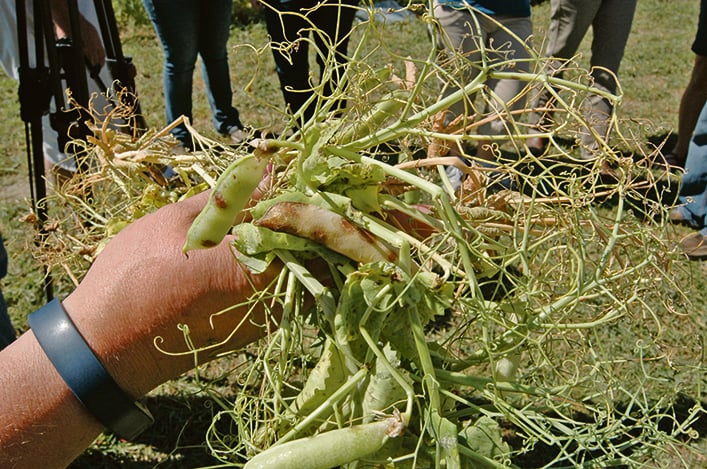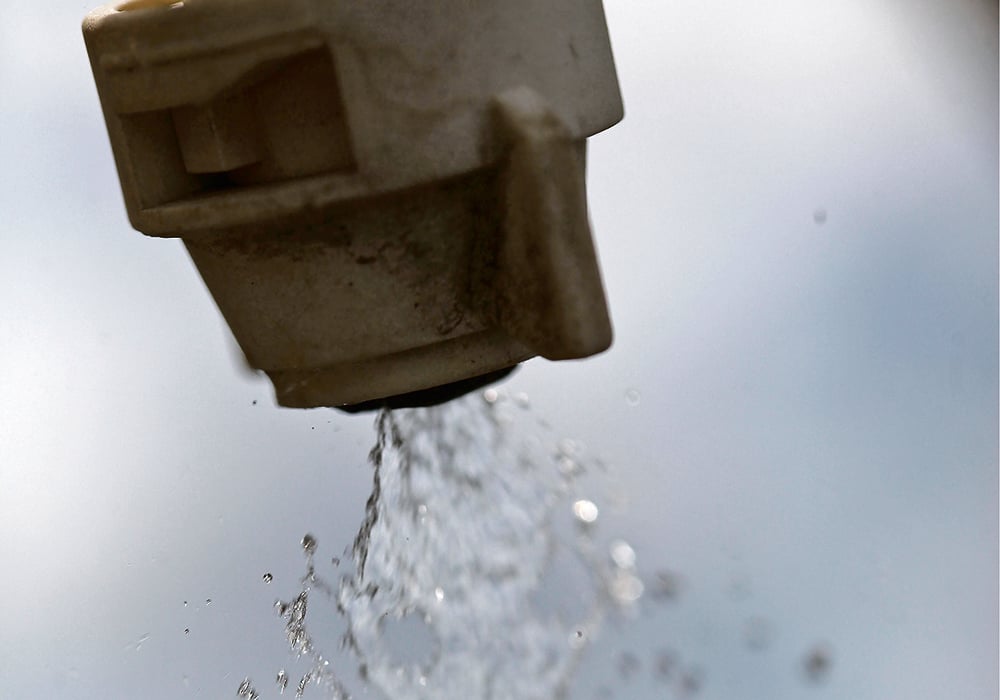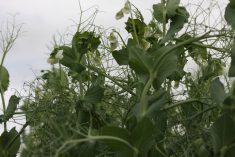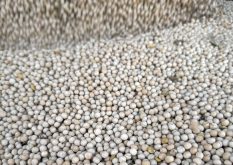Deciding on a fungicide application to control mycosphaerella blight (aka ascochyta blight) in field peas can be difficult.
Many variables are at play, including disease occurrence, product selection, application timing, single versus double treatments, application costs and potential returns on investment.
To help, a fungicide decision worksheet is available to take some of the guesswork out of the decision.
The worksheet, developed a few years ago by researchers Ken Lopetinsky and Sheri Strydhorst, assesses environmental factors such as crop canopy conditions, plant densities, leaf wetness, weather outlook and disease symptoms to determine if a fungicide application is warranted.
The worksheet assigns numerical scores to a crop, depending on conditions or risk factors seen during field scouting. A cumulative risk score of 65 or greater signals a fungicide application is warranted and could be expected to result in a net economic benefit for the grower based on higher grain yields, improved seed quality, better standability and improved harvestability, compared to untreated crop.
Laura Schmidt, production specialist with the Manitoba Pulse and Soybean Growers (MPSG), said the worksheet has proven to be valuable, regardless of where it’s used.
“The checklist was actually developed by researchers in Alberta but each of our respective groups (across the prairie provinces) has taken the checklist and we’ve kind of ground-truthed it in our respective regions,” Schmidt said.
“So far, we’re getting pretty consistent recommendations from it, right across the Prairies.”
Mycosphaerella blight is the most common and costly foliar disease of field peas in Western Canada.
In pea disease surveys co-ordinated by Agriculture Canada and conducted in Manitoba between 2020 and 2022, mycosphaerella was observed in 100 percent of monitored pea fields, with an average disease severity rating of three on a numerical scale of 0-9.
The mycosphaerella pathogen exists in the soil and in crop residue. Spores can also be airborne or seed-borne, making disease containment difficult.
Air-borne disease spores can spread over long distances, meaning no field is immune.
In general, however, fields that are part of a diverse crops rotation that includes peas no more than once every four years are much less susceptible.
“Since the spores are windblown, we do expect to find some level of this disease in every pea crop, every year,” Schmidt said.
“For mycosphaerella, we want to see a minimum of four years between pea crops in a field and, if you have aphanomyces root rot, you’ll want to see that rotation break extended even longer,” Schmidt said.
“But generally speaking, a minimum of a four-year break between pea crops is enough to break down the mycosphaerella that’s surviving in your crop residues and your soil….”
It is difficult to predict potential yield losses based on early season disease pressure, but mycosphaerella symptoms seen early in the growing season suggest disease losses can be “quite impactful,” Schmidt said.
To minimize yield and quality losses, growers should scout for mycosphaerella symptoms from the V10 growth stage (10th node) through to early- or mid-flowering.
Yield impact will depend on how early the disease sets in and how quickly it progresses into the upper crop canopy.
Early infections will cause the most damage if left unchecked.
Fungicide applications in the later growth stages, past full pod, are typically not beneficial in terms of limiting yield or quality losses, and increases the risks associated with pre-harvest interval timing for several products.
When scouting, growers should look low in the canopy for small dark spots or freckles on the lower leaves of pea plants.
Disease incidence (the proportion of plants showing symptoms) is more important than disease severity.
“What’s really critical is what time the disease is infecting our peas because those earlier infections are going to cause quite a bit more damage and those are also the ones that we’re looking to control with our foliar fungicide applications to really protect that pea crop during those critical late flowering and early- to mid-pod stages,” Schmidt said.
“So, if we’re seeing those spots and if we’ve also got all the other conditions that are conducive to disease development — things like a dense crop canopy with lots of plant growth, humidity, dampness below the canopy and even if we have any rain in the forecast — those are all the things that are going to come together to really help that disease develop and infect more of the plant….”
“What we’re trying to do (with foliar fungicide applications) is we’re trying to control the spread of mycosphaerella up the plant canopy,” she said.
“In order to minimize yield loss, we want to restrict its movement and contain the disease to that lower third of the canopy and not let it progress any further.”

Once an application decision is made, growers should strive to get good fungicide coverage on the lower leaves, an objective that can be challenging particularly in a dense crop canopy.
For optimal canopy penetration, higher water volumes are recommended.
“The best way to get good spray penetration through a dense pea canopy is with water volume,” said Tom Wolf, an application specialist and researcher with Agrimetrix Research and Training in Saskatoon.
“In our studies using fungicides… in dense chickpea canopies, we found that water volume was by far the most powerful way to get better penetration, deeper down.
We also tried different nozzles. We tried finer and coarser droplets — no difference. We tried twin nozzles, backward and forward, spraying simultaneously, versus a single nozzle — no difference. But when we adjusted water volumes, going from 10 gallons to 20 gallons, we saw a very significant improvement in canopy penetration.”
“And when we went even higher than that, we saw a further improvement, so we felt that water volume is perhaps the most important thing to focus on.”
In similar research conducted in field peas, Wolf said spray droplet size was not a significant factor but water volume was once again an important consideration.
When fungicides were applied at rates of five, 10 and 15 gallons per acre, Wolf saw a significant improvement in canopy penetration each time the water volume was increased.
Improved coverage was particularly noticeable in the lower canopy, where mycosphaerella fungicides are typically targeted.
Fungicide labels will normally provide a range of recommended water volumes.
Additional information may be included relating to the addition of non-ionic surfactants to maintain product efficacy at higher water volumes. Read labels carefully and consider adding a surfactant at higher water volumes, if warranted.
Product selection is another important consideration.
MPSG is co-ordinating fungicide comparison trials in Manitoba but those trails are still in their early stages, so data and product recommendations are still a ways off.
In the meantime, growers should be mindful of the growing risk of resistance to Group 11 fungicides.
“Group 11 resistance isn’t typically an issue in peas because most of our registered fungicide products are a combination of Group 3s, Group 7s and Group 11s, but certainly, we do want to avoid applying a Group 11 fungicide alone because we’re probably selecting for more resistance and we might not be getting the best control with Group 11 products when they’re used alone,” Schmidt said.
“We do want to use multiple modes of action and, if we are going back in for a second applications, that’s when you’ll want to rotate fungicide active groups, just to prevent some of that resistance from developing any further.”
Schmidt also recommended that growers time their pea-scouting properly, refer to the fungicide decision-making worksheet and be prepared to act quickly if conditions warrant an application.
“That early pea flowering time is a really busy time for scouting peas because not only are we looking for mycosphaerella or ascochyta blight, but we’re also looking for nodulation and we’re also looking for pea aphids, so it’s a really busy time,” Schmidt said.


















